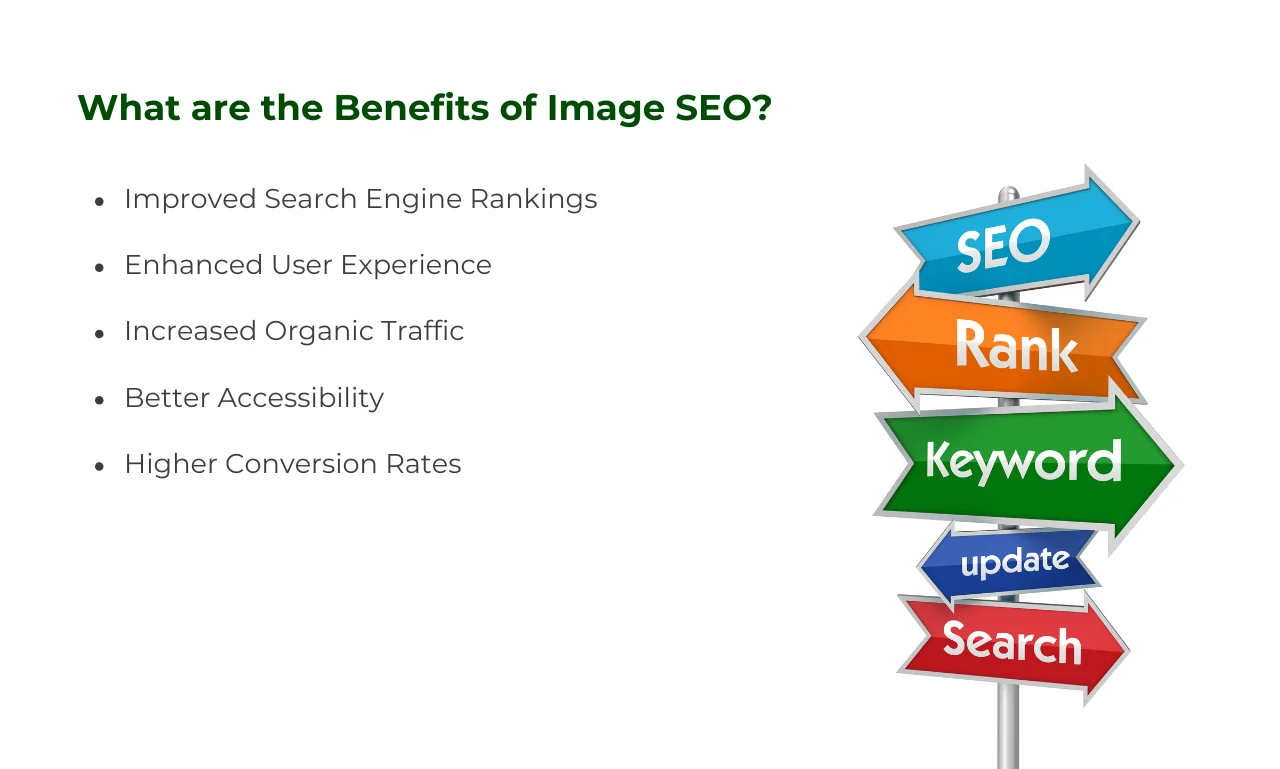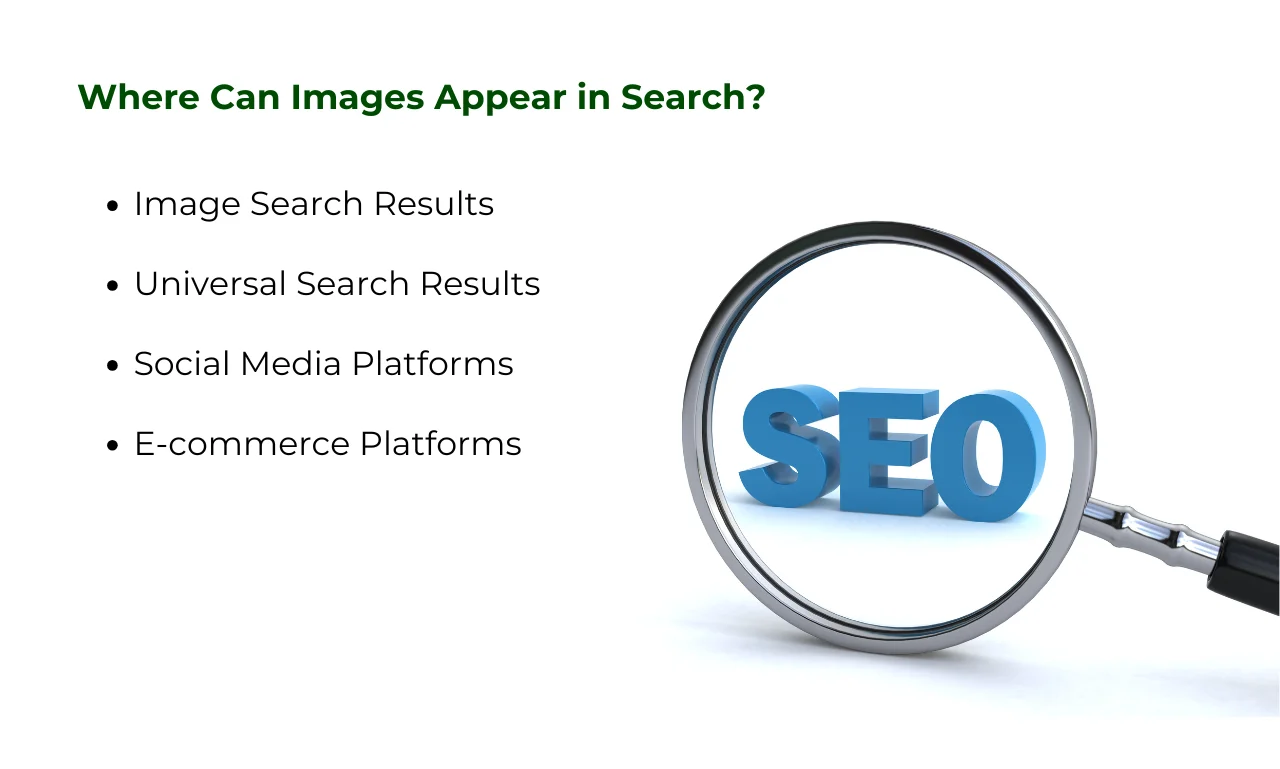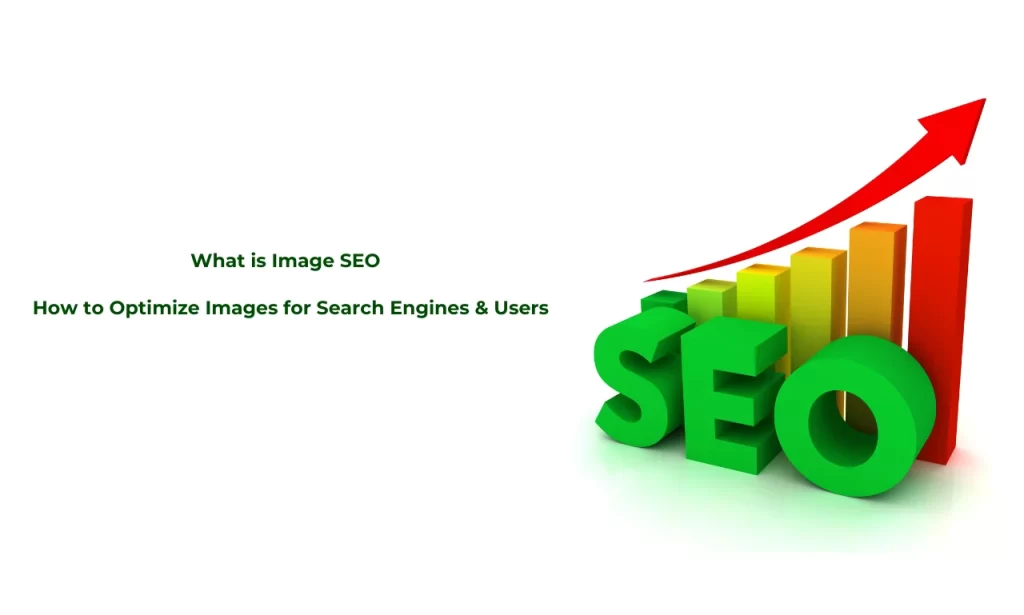Pictures are considered very useful when used in writing as they make writing more interesting.
Google mentioned the fact that one billion image searches are made daily which highlights the significance of well optimized images.
Moreover, pictures are vital in online marketing as they provide the foundation of an effective and captivating experience in the world of the internet.
Regardless of the amount of experience you have in marketing, it’s crucial to determine the function of image in user experience and SEO.
Here in this blog, you will learn about what is image SEO and how you can optimize them for search engines & users.
1. What Is Image SEO?
Image SEO is the practice of optimizing your website images so that they appear in the search engine result pages (SERP) when the relevant keywords searched in the internet.
This includes proper naming, file format and assigning of appropriate alt text to images, in a manner that these makes it easier for users to relate to them while also increases the outward visibility to search engines.
Importance of Image SEO:
Image SEO is a fundamental component of improving the usability interface and also the ranking of a website.
Moreover, use of high quality and optimized images is an important facet of every website because it influences loading time, ease of access, attraction as well as search engine ranking.
However, with the regular updates in Google algorithms, the focus on images has increased many times due to its significance in SEO marketing strategy.
How Image SEO Complement Other Website SEO Types?
SEO deals with different aspects of site and its images, unlike usual approaches that deal with keywords and text. Altogether such strategies work hand in hand to achieve a maximum focus and attention with an aim to increase the chances of conversion.
As far as image SEO relationship with other SEO types is concerned, it can help in On page SEO by optimizing HTML elements. Concerning technical SEO, it can help in improving website speed and loading time. At the end, Image SEO also contribute to building authority and upgrading user experience which are most important aspect of Off-page SEO. 
2. What are the Benefits of Image SEO?
While most Webmasters consider image optimization as a way of enhancing the beauty of website pages, there are several real advantages to optimization of images. Here are some benefits of Image SEO which can help you in the optimization:
Improved Search Engine Rankings
When images go through the correct optimization techniques, there is a high tendency of gaining better positions in the SERPs.
Search engines such as Google can determine relevance of the images and text and even the texts that act as descriptions for the images.
Categorizing images helps to reach higher traffic rates from the image search, which increases chances of getting the high click-through rate as well.
Enhanced User Experience
The audience always tend to go to websites that are easy and pleasant to the eye to use and navigate.
Images usually help keep the attention on the page and help not to bounce back.
In this case, the focus is on images that are fast to load and of the highest quality.
Every web designer know that optimized images are important in supporting an efficient and good experience of visitors hence affect how longer they spend on a site.
Increased Organic Traffic
Image SEO can stimulate different opportunities of attracting the organic traffic.
In addition, when users search by images that are connected to your content, such images may appear in these searches and attract users who are interested in the content of your site.
Such traffic usually generates more engagement and can bring to your brand people they might not have otherwise encountered.
Better Accessibility
Subsequently, failing to optimize images means you are creating what is a least acceptable website for disabled people.
This is important because users with disability requiring the use of screen reader rely on alt text and image descriptions obtained from it.
For example, when offering the description of images, images with alt text will be helpful to a diverse audience and assist make your website more accessible and visible, especially in case of an indexation in a search engine that prefers sites with maximum accessibility.
Higher Conversion Rates
Optimize images are of great importance because it can control the user’s behavior and decisions.
High quality and well-selected images always capture the user’s attention, increase the credibility, and compel the users to act i.e. click the buy now button, sign up for a newsletter or fill in the contact page.
Therefore, images increase the conversion rate and ultimately help to enhance sales and revenue proceeds.
3. Where Can Images Appear in Search?
SEO optimize images ca appear on different search results which are as follows:
Image Search Results
Images can be seen in the search results of pictures and in image searches such as Google and other related search engines.
This makes it easier for users when they are searching for an image as the browsing results consist of number of similar images represented by small images also known as thumbnail.
This is important for the traffic to be driven directly to a particular site if the images are properly optimized.
Universal Search Results
In the modern day popular SERPs images have become a part of the search layout because of their role in improving the essence of the search.
For example, some HTML tags contain images accompanying descriptions of products, and highlighted brief descriptions contain images for additional information.
If your images are more optimized, then there are good chances that such images can be featured in these Universal Search results.
Social Media Platforms
Optimizing for images is very crucial to find a place in the context of social media searches and feeds.
When users type in search queries on platforms such as Instagram, Pinterest or Facebook, well-crafted images associated with the searched keywords will be attract more traffic than competitors in search engines.
E-commerce Platforms
To the respective business entities involved in the use of e-commerce gateway, images are extremely important in any listing or search.
Appropriately sized, professional photos of the product can enhance the consumers’ appetite and encourage them to purchase the product and contribute to reduced bounce rate.
4. How to Optimize Images for SEO
This is a set of procedures and techniques that should be followed in order to ensure that images are well optimized to suit both the SEO factors as well as enable them to enhance the users experience. Here are various strategies that could be applied for the same:
Use High-Quality Images
The higher-quality and better-looking quality images are more effective source to attract the users.
Seeing professionally made images in the websites leaves an impression that triggers the users into taking more time into the site.
It is advisable to hire professional photographers or get high-quality stock photos to put up good representation.
Moreover, also don’t compromise the quality of images even when you used them in GMB (Google My Business) if you want to build impression of your brand on your customers.
Compress Images for Faster Loading
Having a large image file size hinders the loading speed of your website and this is likely to cause high bounce rate among visitors.
Apps such as TinyPNG, JPEGmini, and ImageOptim can be used in making image file sizes slightly smaller without losing the image quality.
Image compression improve faster image loading as well as also improves the perception of users and search engine result page performance.
Use Descriptive File Names
While saving the images, the image file names should be meaningful and contain the keywords of the subject.
Do not name an image as IMG-1234.jpg but as digital-marketing-agency.jpg. This is useful in making the search engine to understand what information is contained in your images so as to improve its indexing.
Add Alt Text
Image description also referred to as alt text which is a written explanation of an image mainly used by the screen reader and the search engines.
Writing meaningful and keyword-focused alts makes the site more accessible and makes it easier for engines to determine what the image is about.
Use Captions and Surrounding Text
It’s used for adding captions or contextual text around the images so they would be more relevant.
This additional text assists to inform the search engines about the context of the image and even help the image to rank better in the search engine results.
Choose the Right Image Format
It is very important that the right image format is adopted depending on its use with regard to both quality and loading time.
JPEG is best suited for photographs while PNG is maybe okay when working with images that need to have a background with an alpha channel or one that is semi-complex, WebP is a fine choice in terms of quality with reasonable compression.
When deciding on the file format of the image to create it in, choose the format that is appropriate for the purpose of the image and its content.
Implement Responsive Design
Another feature that can be observed in responsive design is images which are made in a way that will make them fit into any device or screen.
Responsive images should be used which means that different-sized images are served based on the user’s device with help of CSS media queries and appropriate techniques.
Leverage Image Sitemaps
An image map is an XML file that defines the location of all the images on a site to feed the search engine with fuller information.
Submitting an image sitemap is also beneficial in ensuring that the images end up being discovered quickly by the search engines while submitting an image sitemap is also important in making the job of the search engines easier by informing them on the images that you have posted online.
Optimize Image Dimensions
All images that are utilized should be the correct size to be used to prevent the need for scaling.
Size specification ensures that time taken to load an image is minimized greatly which ultimately improve the user experience.
Add Structured Data
Applying schema markup improves its image search results in such a way that the image will stick to.
Structured data also benefits and improves how the search engines crawl the actual images, because the tagging make it easy for the search engines to understand the content of the images and leads to rich snippets in the SERPs.
Use Lazy Loading
Lazy loading means that images are loaded only when a web visitor scrolls down to that part of the page where the images are located.
This technique increases the speed of the page and the performance of the site and in particular the first views for users with many pictures.
Avoid Stock Images When Possible
It is refreshing to think of incorporating original and unique images that will differentiate your brand from the rest.
Although using stock images may save some time and effort, using personal photos is more appropriate and helps avoid the appearance in the search as objects that are irrelevant to the brand.
Optimize for Mobile Devices
With the ever-growing use of smart phones, optimizing images for mobile devices is pivotal.
By properly optimizing images for high speed mobile devices, you can easily enhance the usability of the CND website and it’s performance on search engine results.
Monitor Image Performance
Photo tagging involves using analytic tools that enables you determine the performance of the images.
Analyse the traffic’s rate, duration, and engagements to see where you can make changes that would be beneficial to the SEO of your images.
Regularly Update Images
To avoid finding it messy and untidy just refresh the images as often as possible.
New images are likely to bring back people, while the stale ones might give an impression that the website is outdated.
5. How to Check Your Site’s Images?
The following are some major ways through which you can check your site’s images:
Use Google Search Console
Google Search Console is also effective to see when and how your site is indexed for images as well as any SEO problems regarding the images. It offers some information about your images at the Google image search and explains which pictures are more popular among the users. Daily use of it helps you solve some issues which could be related to broken links or the images that fail to load correctly.
Conduct an Image Audit
Image audit brings out the areas that need change and finds out opportunities for optimization. This pertains to the technical aspect of going through which consists of images used in a particular site to consider SEO recommendations. It is recommended to locate large images that, when opened, take a long time to load, all the images should have descriptive text information, as well as file names should be as meaningful as possible.
Test Image Loading Speed
The loading speed of images also determines the experience that the users are going to get as well as the SEO performance. Google PageSpeed Insights is one such tool that can be used to determine the speed at which the images are loading on various devices and connections. When images are not optimized, they harm the loading speed, the bounce rate and the position of your website in the search engines.
Check Alt Text and File Names
While providing image descriptions in the text, it should always be completed with alt=text and a crystal-clear file name. It makes the job of the search engine to understand what is being depicted in the image and enhance the probability of touching the base of the challenged people. Likewise, use of of file names and other related keywords should be appropriate as search engines also use it to identify your content.
Verify Responsive Design
The use of mobile devices has become more and more popular, it is important to make sure that your images can be viewed just as easily on a mobile device as they are on a desktop computer. To do this, use different screen sizes to identify how different images are scaled correctly without compromising on their quality. Responsive images help improve the interactivity of the site which makes it more user friendly in addition to contributing to good SEO positioning.
Analyze Image Traffic
By knowing the role that images play in the level of traffic and interaction on the website is crucial. Include the use of other analytic tools that will help track the rate at which the image is being viewed, clicked, and shared. This information can help you understand which images entice users and which images did well in order to decline the image strategy.
Final Thoughts:
SEO works in imagery as a unique approach that optimizes image by improving on-page presence substantially and increasing traffic. So, by knowing when images appear for searches and the usage of the given tips on image SEO, website owners can optimize images for the benefit of the search engines and clients. And do not forget that the aesthetic and impactful look of the website along with its usability to the audience and tweaks made to adjust to the standards of SEO is the main idea.
Three Angle Marketing is ready to help you achieve the maximum result with image SEO marketing. If you’re searching for help to perform an audit for the images, minimize the time that takes to display the images, or generally enhance the overall image campaign of your website, our experts in SEO are ready and willing to assist you. Please get in touch with us now to discover how we can help your website achieve more with the appropriate image optimisation.


